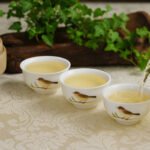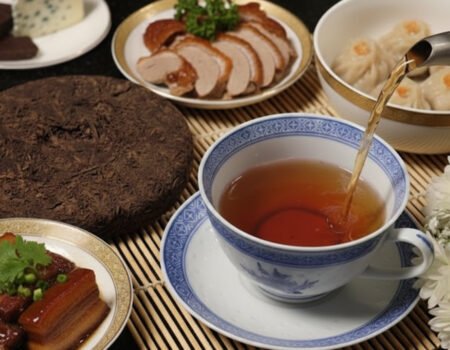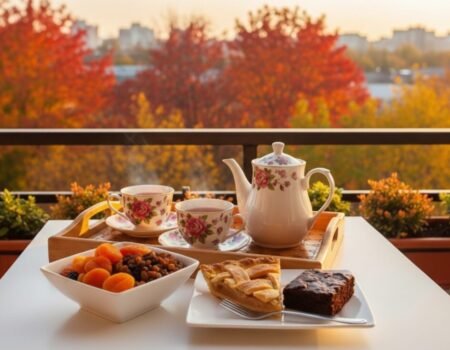
Savory Tea: A Delicious Twist on Traditional Tea
Index
Savory tea might sound unusual to some tea enthusiasts, but it simply blends herbs, spices, and vegetables to create complex and fascinating flavors beyond traditional sweet infusions.
This guide will show you how to pair tart, acidic, and spicy elements with different tea bases for a whole new drinking experience!
Key Takeaways
- Savory tea pairs tart, acidic, and spicy elements with tea bases to create complex flavors beyond traditional sweet options.
- The basic rule for successful pairings is to match intensity levels – strong flavors with robust teas like Assam, subtle additions with delicate white teas.
- Popular combinations include lime with Sencha, pomegranate juice with Darjeeling, sumac with Lapsang Souchong, and za’atar with chamomile.
- Brewing temperature matters greatly – white and green teas need cooler water (170-185°F/ 76-85°C), while black teas require hotter water (210°F/99°C).
- Savory tea traditions span cultures worldwide, from Moroccan mint tea to Turkish çay with börek pastries, showing tea’s versatility beyond sweetness.
Understanding the Art of Savory Tea Pairing
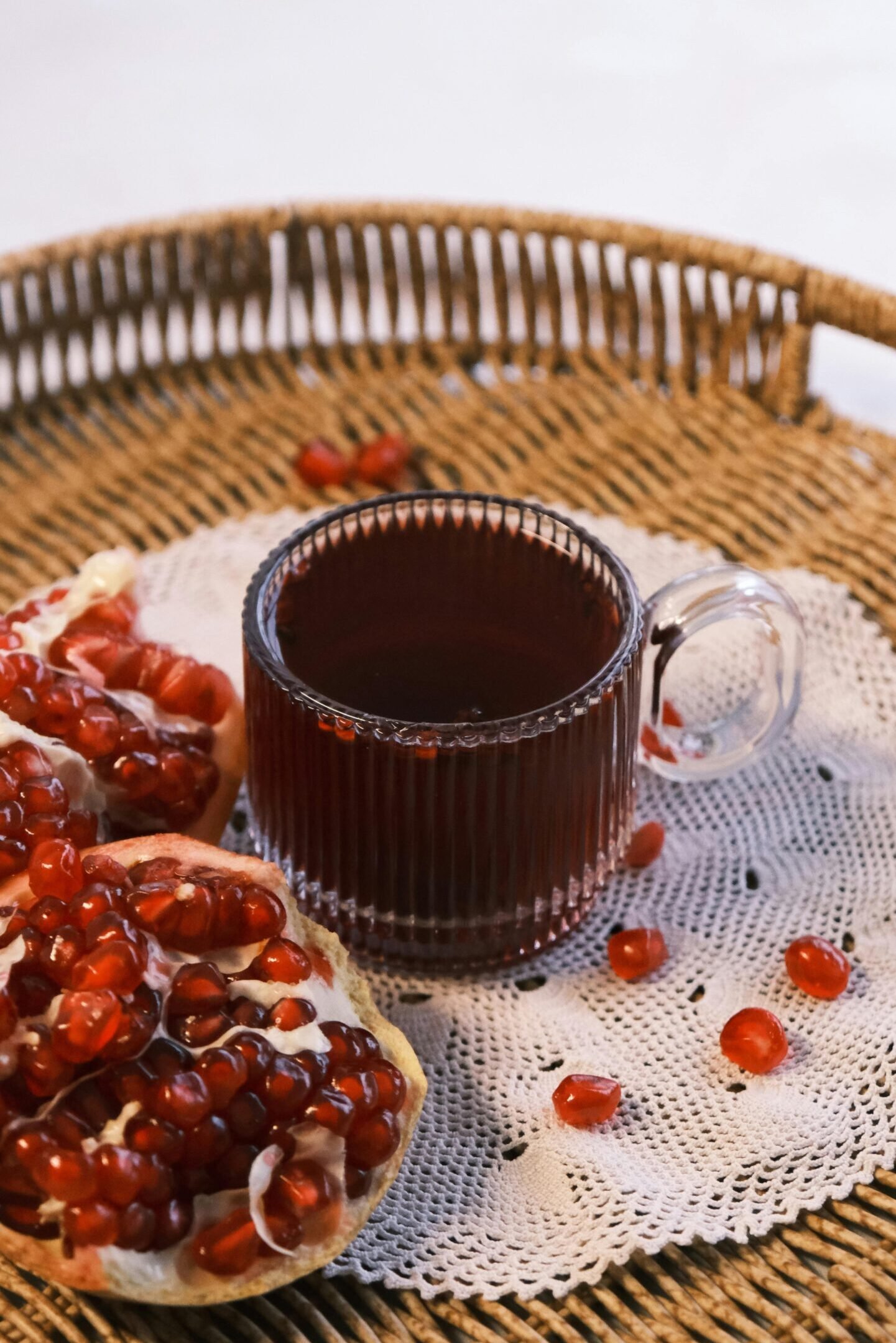
Savory tea pairing blends science and art to create flavor matches that sing on your taste buds. You’ll discover how certain tart or umami elements bring out hidden notes in your favorite teas, much like wine pairings enhance a meal.
The Science of Contrast and Complement
Tea pairing works through two main strategies: complementary and contrasting flavors. Complementary pairings match similar taste profiles, like adding umami-rich mushroom to enhance green tea’s natural umami notes.
Contrasting pairings create balance by offsetting one strong flavor with another, such as mixing tart lime juice with sweet Sencha green tea. These combinations work because our taste buds respond to five basic tastes—sweet, bitter, salty, sour, and umami—which interact in complex ways on our palate.
Success in savory tea mixing depends on understanding flavor intensity and balance. Black teas with robust profiles stand up well to strong additives like pomegranate or sumac, while delicate white teas pair better with subtle flavors.
Temperature plays a crucial role too; proper steeping extracts the right compounds for ideal flavor matching. Many cultures have practiced this flavor science for centuries, adding ingredients like barberry to Ceylon or za’atar to chamomile for taste enhancement.
The best combinations create a harmonious blend where neither the tea nor the savory element overwhelms the other.
Matching Tea Intensity with Additive Strength
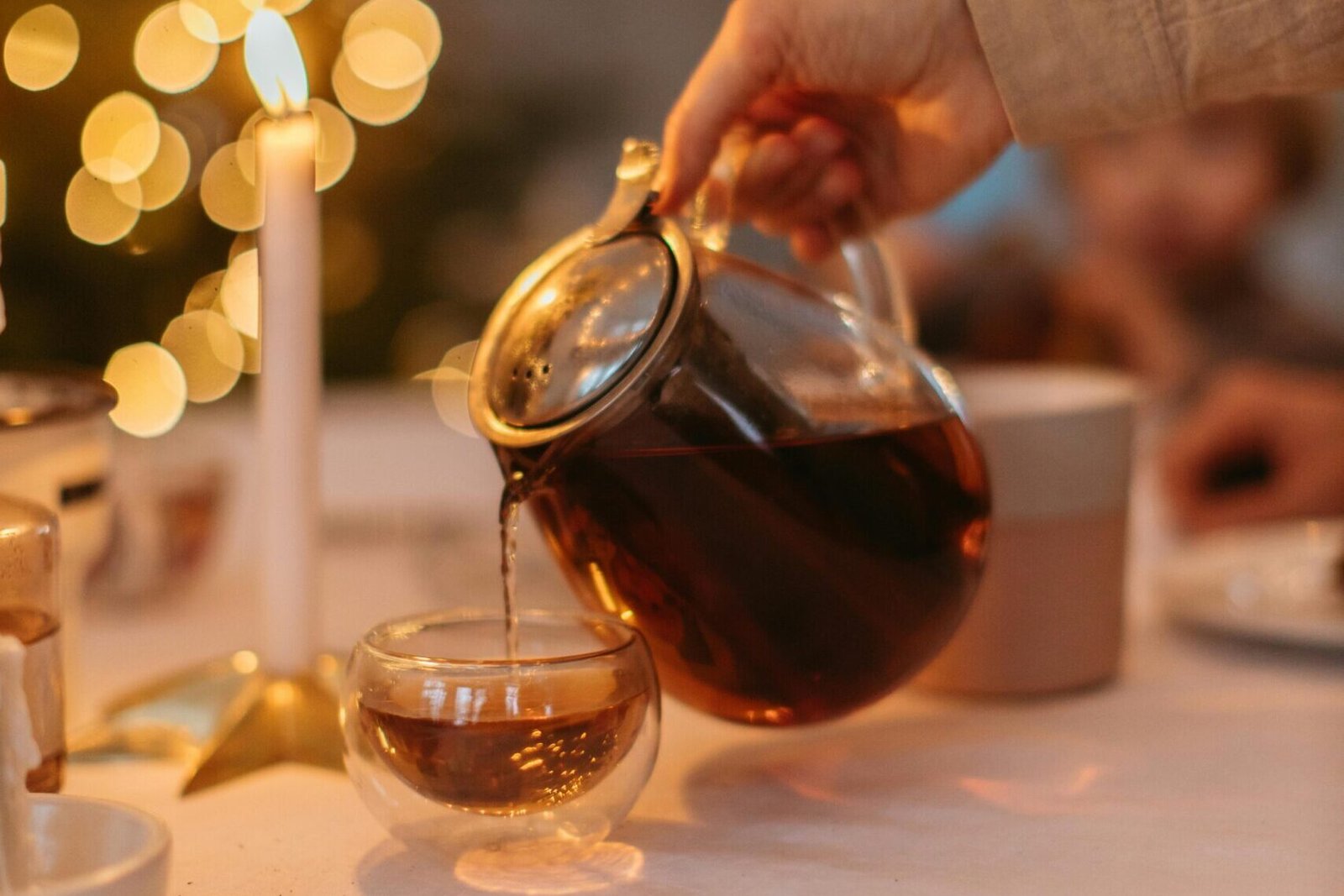
Tea flavors range from light to bold, and your savory additions should match this strength. Delicate white teas need subtle partners like sea buckthorn that won’t overpower their nuanced notes.
A robust Assam black tea stands up perfectly to strong tamarind paste, creating a balanced flavor profile where neither element disappears. The basic rule works simply: pair strong with strong, light with light.
This balance matters most in creating successful combinations. Floral oolongs cut through rich, umami foods while maintaining their distinct character. Brewing methods also affect this balance – longer steeps extract more flavor, requiring adjustments to your savory elements.
Many tea lovers find that Lapsang Souchong’s smoky profile pairs beautifully with tangy sumac, creating a harmony where both flavors enhance rather than fight each other. This careful matching transforms an ordinary cup into a complex flavor experience.
Green Tea Savory Pairings
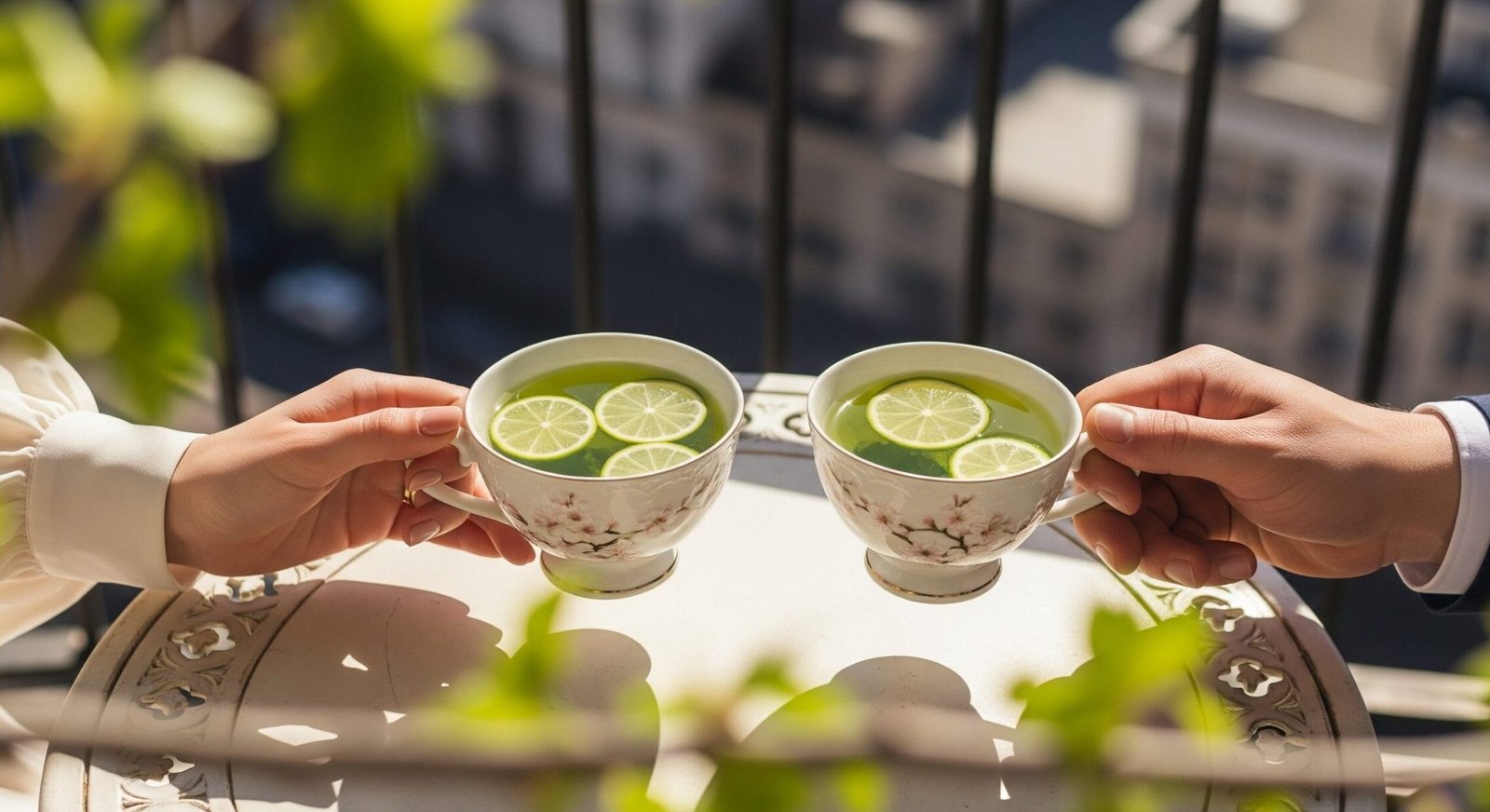
Green tea‘s light profile makes it perfect for savory pairings that bring out its fresh notes. These pairings create new taste dimensions that transform your daily cup into an exciting flavor journey.
Lime and Sencha: A Vibrant Citrus Experience
Japanese Lime tea offers a bright flavor explosion that wakes up your taste buds. This zesty blend combines whole leaf Japanese Sencha green tea with daisy blossoms, lemon peel, and lime peel for a refreshing cup.
The citrus notes cut through the grassy Sencha base, creating a perfect balance that works hot or iced.
Brewing this vibrant tea requires careful attention to temperature. Heat water to between 65°C and 77°C, then steep for 3 to 4 minutes to extract optimal flavor without bitterness; An affordable luxury for tea enthusiasts seeking something beyond traditional options.
Yuzu and Jasmine: Floral Meets Tangy Elegance
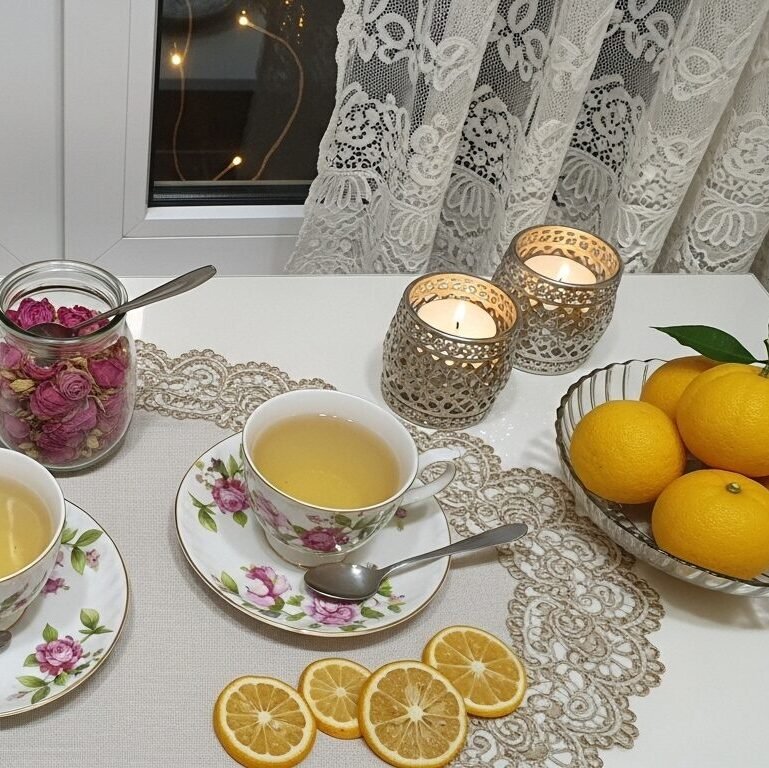
Yuzu, an aromatic East Asian citrus fruit with a flavor often compared to a blend of grapefruit and lemon, brings bright citrus notes that dance perfectly with jasmine’s delicate floral character in this elegant tea pairing. The Kyoto blend from The Tea Nomad showcases this harmony with sencha green tea as the base, adding pink rose petals and dried orange peel for depth.
This blend also comes in smaller packaging making it easy to sample before committing to a larger size.
The natural yuzu essence cuts through the sweetness of jasmine flowers, creating a balanced cup that feels both refreshing and sophisticated. Tea drinkers often note how the dried apple pieces add a subtle sweetness that rounds out the tangy citrus punch.
This combination works best brewed at lower temperatures (175°F / 80°C) to preserve the gentle flavors inspired by Japanese gardens and traditions.
Black Tea Savory Combinations
Black tea offers the perfect base for bold, savory add-ins that create unique flavor profiles. These pairings bring out the deep notes in black teas while adding tart, smoky, or spicy elements that transform your cup into something truly special.
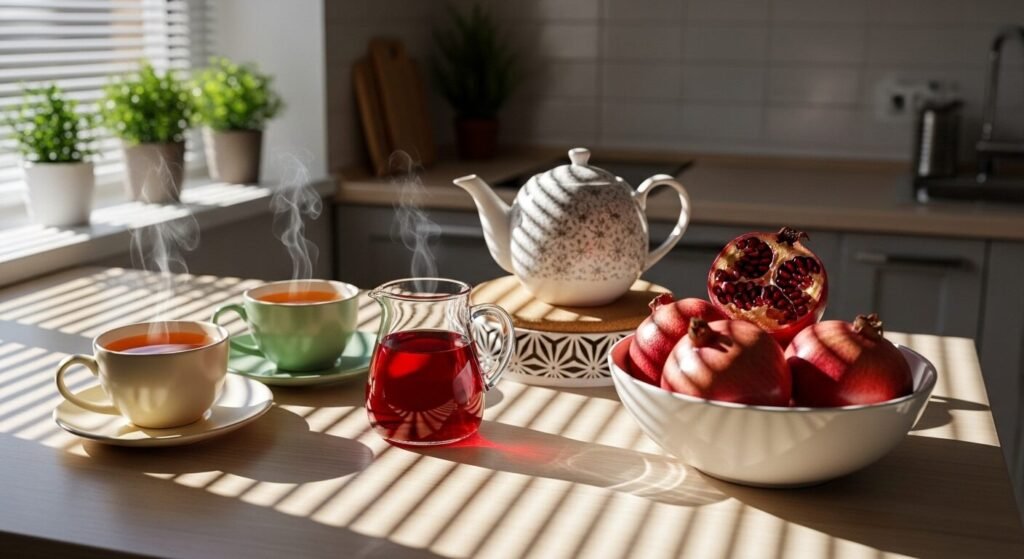
Pomegranate and Darjeeling: Complex Depth
Pomegranate juice creates magic with Darjeeling black tea, offering a tangy twist that breaks free from sweet tea traditions. This pairing brings out hidden notes in the tea while the fruit adds a tart depth that tea lovers find exciting.
The bright acidity of pomegranate cuts through Darjeeling’s muscatel character, creating a savory profile that surprises the taste buds.
Try this blend at your next tea party for a unique caffeine experience that guests won’t expect. Simply adjust your brewing temperature based on how strong you want the flavors to mingle – hotter water pulls more tannins from the leaves, while cooler temps keep things gentle.
Many tea fans report this combination works equally well hot or as an iced tea, making it perfect for any season.
Sumac and Lapsang Souchong: Smoky-Tangy Harmony
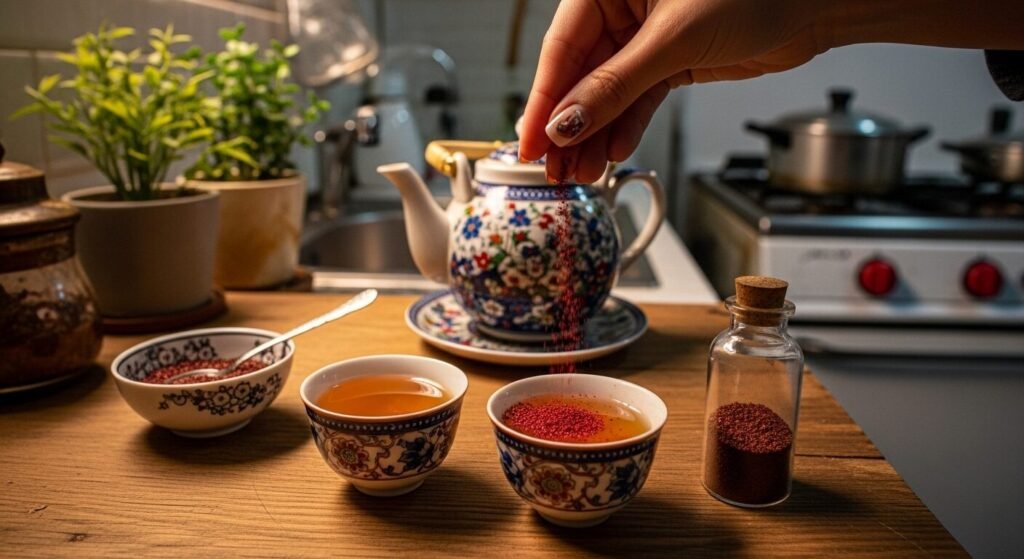
Sumac’s bright, lemony tang creates magic with Lapsang Souchong‘s pine-smoked depth. This Chinese black tea, dried over burning pine needles, brings a campfire essence that balances perfectly with sumac’s Middle Eastern zip.
We love sprinkling a pinch of ground sumac directly into the brewed tea or using it as a rim garnish on your cup for a striking visual effect.
The pairing works best with a strong brew of Lapsang Souchong steeped for 4-5 minutes at 205°F / 96°C. The tea’s robust body stands up to sumac’s tartness without either flavor overwhelming the other.
This combination offers a unique savory tea experience that bridges culinary traditions from China to the Levant. Next, we’ll explore how tamarind’s sweet-sour profile complements the malty strength of Assam tea.
Tamarind and Assam: Bold and Robust Fusion
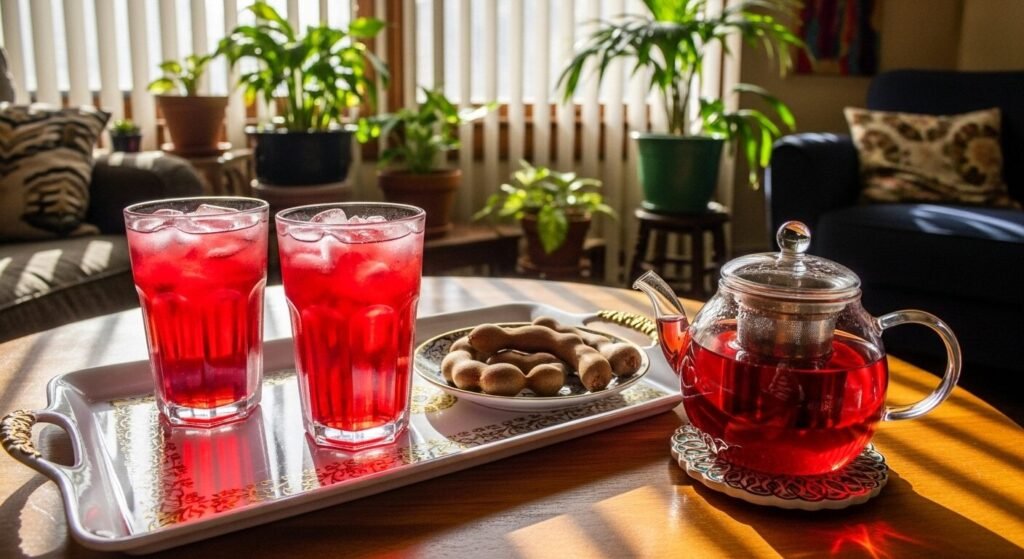
Tamarind brings a perfect tangy punch to Assam’s rich profile. This pairing works because Assam tea delivers a vibrant red brew with full-bodied flavor notes of honey and caramel. The sweet toastiness of this black tea stands up beautifully against tamarind’s sour-sweet taste.
Many tea lovers find this combination creates a complex flavor that balances boldness with brightness.
Try this fusion hot or iced for a refreshing twist on afternoon tea. The natural acidity in tamarind cuts through Assam’s depth, creating a drink that wakes up your taste buds. You can adjust the strength by steeping the tea longer or adding more tamarind paste to match your preference.
This savory tea option offers a tart alternative to typical sweet tea recipes while showcasing flavors from both Indian and Southeast Asian food traditions.
Black Lime and Keemun: Fermented Citrus Sophistication

Black lime, also known as dried lime, noomi basra (Iraq) or limoo amani (Persian cuisine) brings a unique fermented tang that pairs perfectly with Keemun tea‘s smoky profile. This Chinese black tea offers toasty notes that create a base for the dried lime’s complex citrus flavor.
The tea’s reddish amber color and medium body stand up well to the bold taste of black lime without being overwhelmed. For the best results, use one teaspoon of Keemun per six ounces of boiling water and steep for three minutes before adding your black lime.
The magic happens in the cup as the moderate astringency of Keemun balances the sharp, preserved citrus notes. This pairing works best served hot, allowing the aromatic qualities of both ingredients to blend fully.
Many tea fans enjoy this mix in the afternoon when its sophisticated flavor profile can be fully appreciated. Next, we’ll explore how white and herbal teas create equally stunning flavor combinations with savory elements.
Barberry and Ceylon: Sharp Tartness Meets Brisk Notes
Barberry brings a bold, tart punch that perfectly balances Ceylon black tea‘s crisp, brisk flavor profile. This unexpected pairing creates depth without sweetness, offering tea lovers a new taste adventure beyond traditional cream or sugar additions.
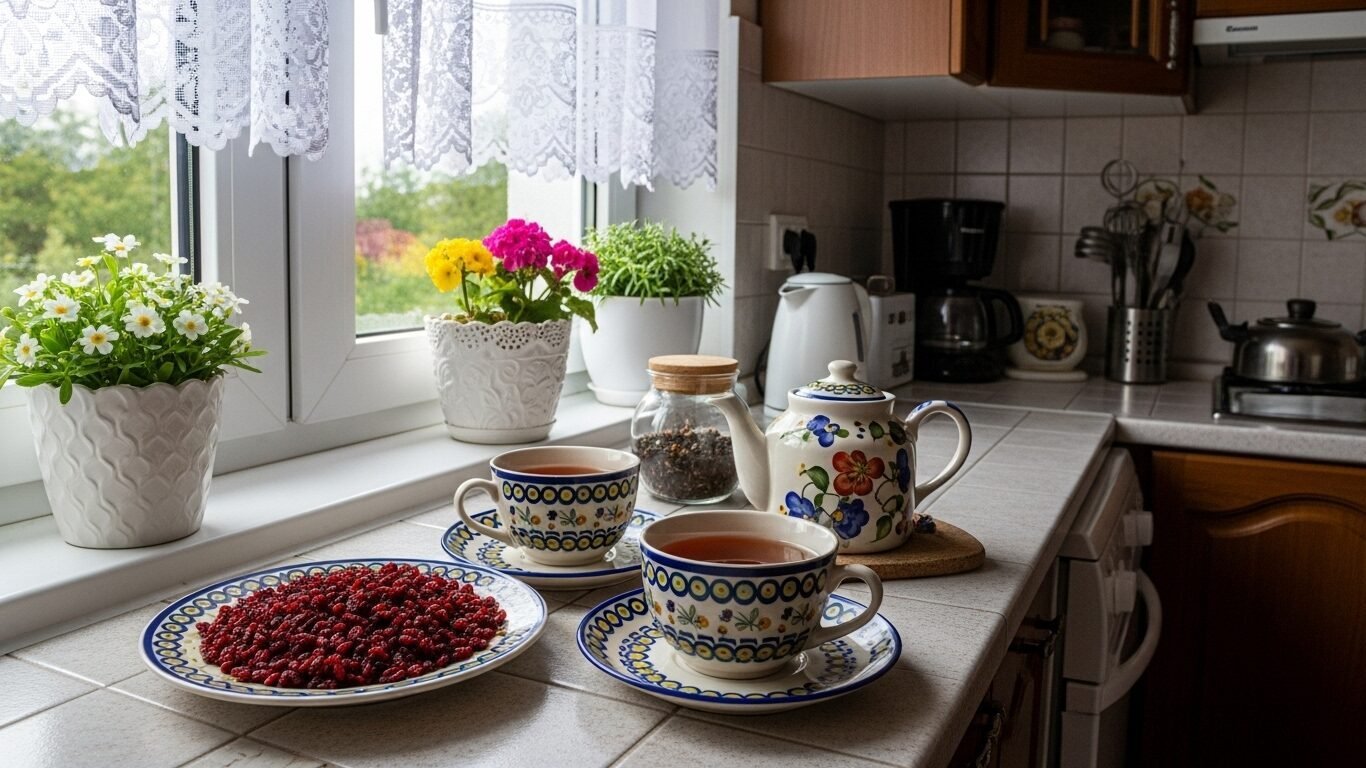
The dried red berries add visual appeal to the amber-colored Ceylon brew while boosting the tea’s natural complexity.
Ceylon tea serves as an ideal base for savory experiments due to its clean finish and medium body. For the best results, brew this combination at 205°F / 96°C for 3-4 minutes, allowing both flavors to fully develop.
This low-calorie beverage works beautifully as both a standalone drink and a cooking ingredient, making it a versatile addition to any kitchen. Many tea enthusiasts enjoy this pairing as an afternoon pick-me-up that stimulates the palate without heaviness.
White and Herbal Tea Savory Blends
White and herbal teas offer a perfect canvas for bold savory flavors that might surprise your taste buds. Their subtle profiles create space for tart and spicy notes to shine without getting lost in the mix.
Cranberry and Rooibos: Nutty-Tart Balance

Cranberry Autumn tea brings together the sharp tartness of cranberries with the natural nutty sweetness of rooibos for a perfect flavor balance.
This caffeine-free blend includes hibiscus and elderberries alongside the main ingredients, creating a ruby-red cup that warms both body and spirit.
The natural earthiness of rooibos provides a smooth backdrop that lets the bright cranberry notes shine without overwhelming your taste buds. Tea fans appreciate how the orange hints add depth to this savory creation while maintaining its refreshing quality.
This pairing works equally well hot on chilly evenings or iced during warmer months, proving that savory teas offer versatility beyond traditional options.
Za’atar and Chamomile: Herbaceous Calm

Za’atar and chamomile create a powerful herbal tea blend that goes well with winter colds and flu. This mix pairs dried chamomile flowers, packed with antioxidants, with wild thyme leaves that contain natural antibacterial properties.
The earthy, herbaceous notes of za’atar (a Middle Eastern spice blend featuring a blend of dried thyme/oregano/marjoram, tangy sumac and toasted sesame seeds) balance perfectly with chamomile’s gentle, apple-like sweetness. You can enjoy this soothing drink hot or cold, depending on your mood or the season.
The brewing process matters with this savory tea combination. Steep the dried herbs for 5-7 minutes in water just below boiling point (around 195°F/ 90°C) to extract the full flavor profile without bitterness.
This tea works wonderfully after meals or before bedtime to promote relaxation. Sea buckthorn and white peony offer another exciting flavor adventure for those wanting to explore more delicate complexity in their tea journey.
Sea Buckthorn and White Peony: Delicate Complexity
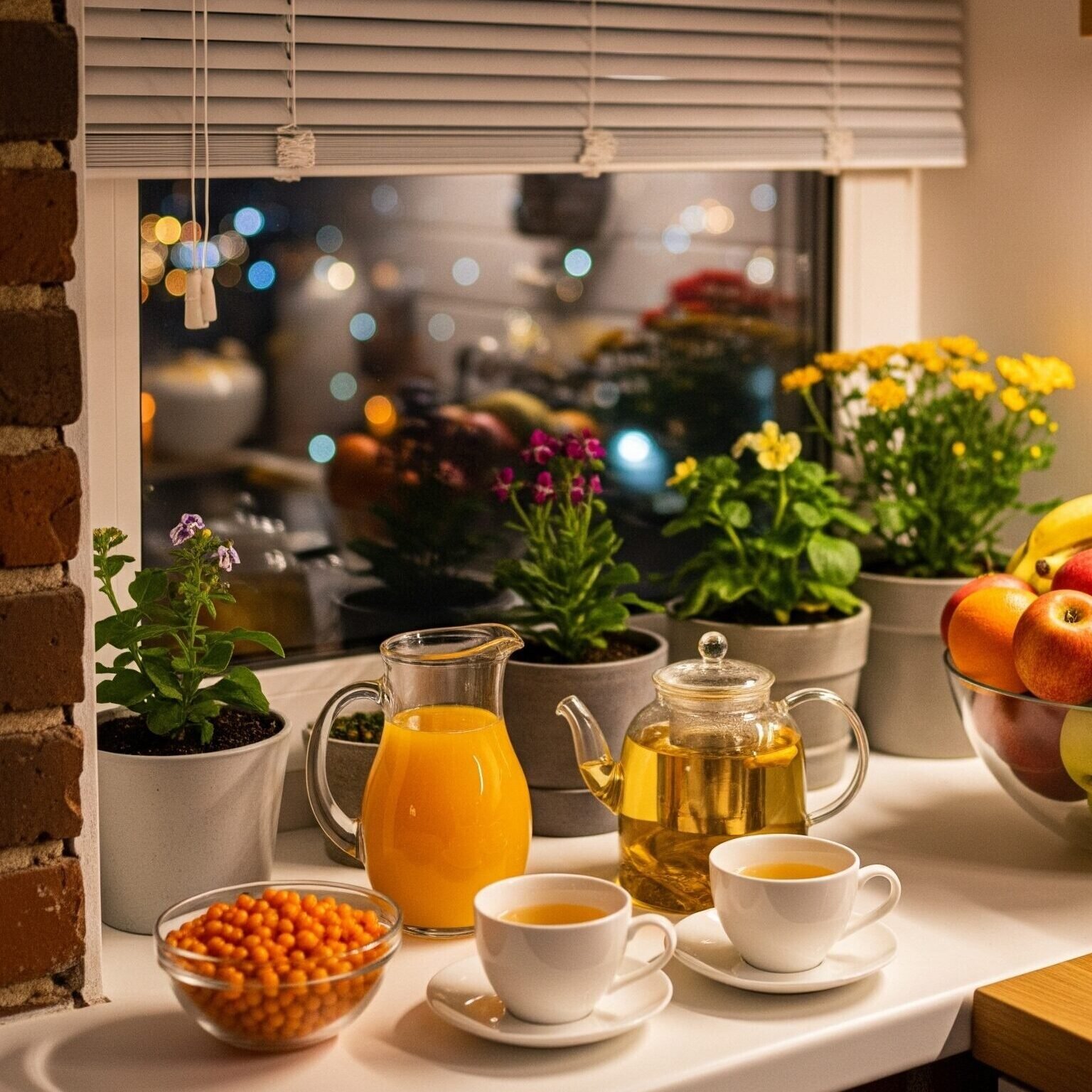
Sea buckthorn pairs beautifully with White Peony tea to create a flavor profile that balances tart and sweet notes. This blend combines white tea with dried fruits like pineapple, apples, and apricots, plus natural sea buckthorn flavor.
The bright orange berries add a tangy punch that complements the delicate floral notes of White Peony without overwhelming them.
You can enjoy this savory-sweet combination year-round, either hot on cool evenings or iced during summer months. The tea’s light body carries the fruity flavors well while maintaining the characteristic softness of white tea.
Cultural traditions that blend herbs and fruits with tea provide inspiration for exploring more unusual savory additions to your daily cup.
Cultural Traditions Behind Savory Tea Pairings
Tea customs across the globe reveal a deep history of savory tea traditions dating back thousands of years. Different regions have created unique blends that reflect local tastes, from Moroccan mint tea with its bold herbs to Tibetan butter tea’s rich, salty profile.
Historical Significance of Tart Additives

Tart additives have played a vital role in tea traditions across many cultures for centuries. Ancient tea masters discovered that adding sour elements like barberry, sumac, and black lime could balance the natural bitterness of tea leaves while creating complex flavor profiles.
These practices spread through trade routes connecting China, Persia, and beyond, with each region developing unique combinations based on local ingredients. Families passed down these special recipes through generations, turning simple tea into a cultural treasure that marked important social gatherings and ceremonies.
Many modern tea blends still honor these age-old techniques while adding new twists. The sharp tang of pomegranate paired with Darjeeling tea reflects Persian influences, while citrus additions mirror East Asian customs.
These tart elements do more than just flavor the tea—they enhance its natural compounds and create a more complete taste experience. Regional tea practices around the world offer even more insights into how different cultures have embraced savory and tart elements in their tea traditions.
Regional Tea Practices Worth Exploring
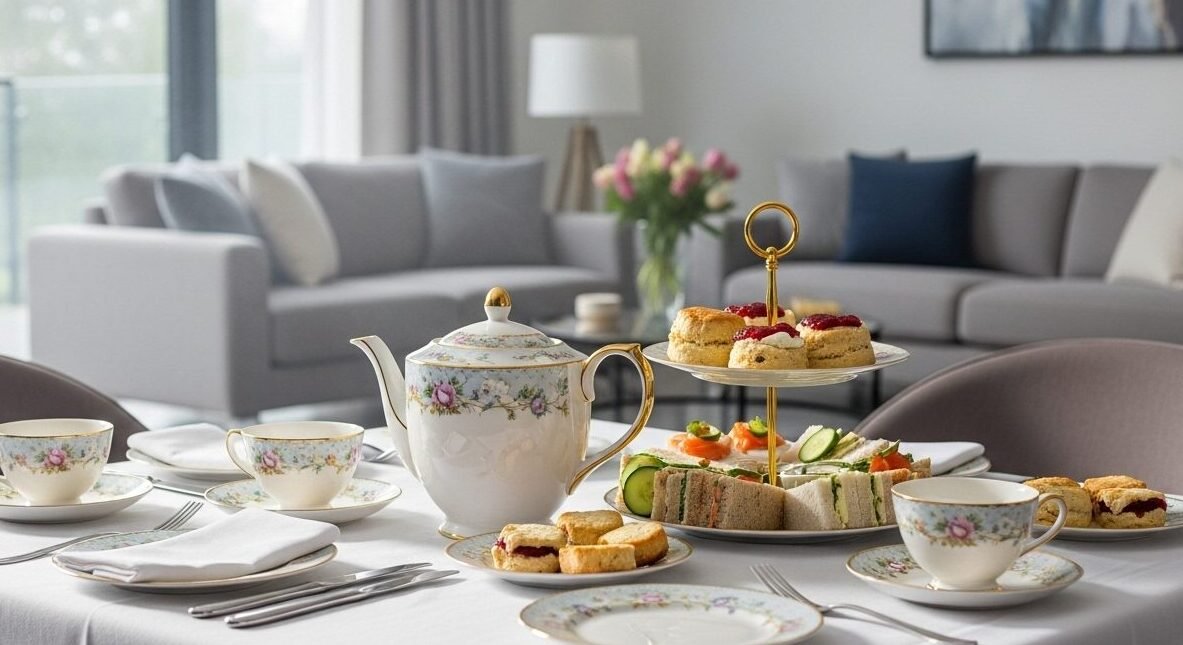
Tea traditions across the globe offer unique savory experiences worth adding to your tea routine. In China, tea lovers celebrate oolong with dim sum during the Gongfu ceremony, creating perfect balance between the tea’s complexity and food flavors.
India brings us masala chai paired with savory samosas, where the spiced tea complements the crisp pastry snacks. Turkish tea culture features strong black “çay” served alongside savory börek pastries, showing how the robust tea cuts through rich flavors.
Japanese tea practices stand out with their matcha and wagashi pairings in the chanoyu ceremony. The bitter notes of matcha balance perfectly with sweet treats. Moroccan mint tea symbolizes friendship and hospitality, typically served with nuts and gazelle horn pastries.
British afternoon tea offers another approach, with black teas like Darjeeling or Ceylon matched with finger sandwiches filled with cucumber, egg, or smoked salmon. These regional customs prove that tea’s versatility extends far beyond sweet pairings.
Creating Your Own Savory Tea Experiments
Trying your hand at savory tea blends opens a world of taste adventures right in your kitchen. You’ll discover unique flavor combinations by mixing fresh herbs, spices, and tart elements with your favorite tea bases.
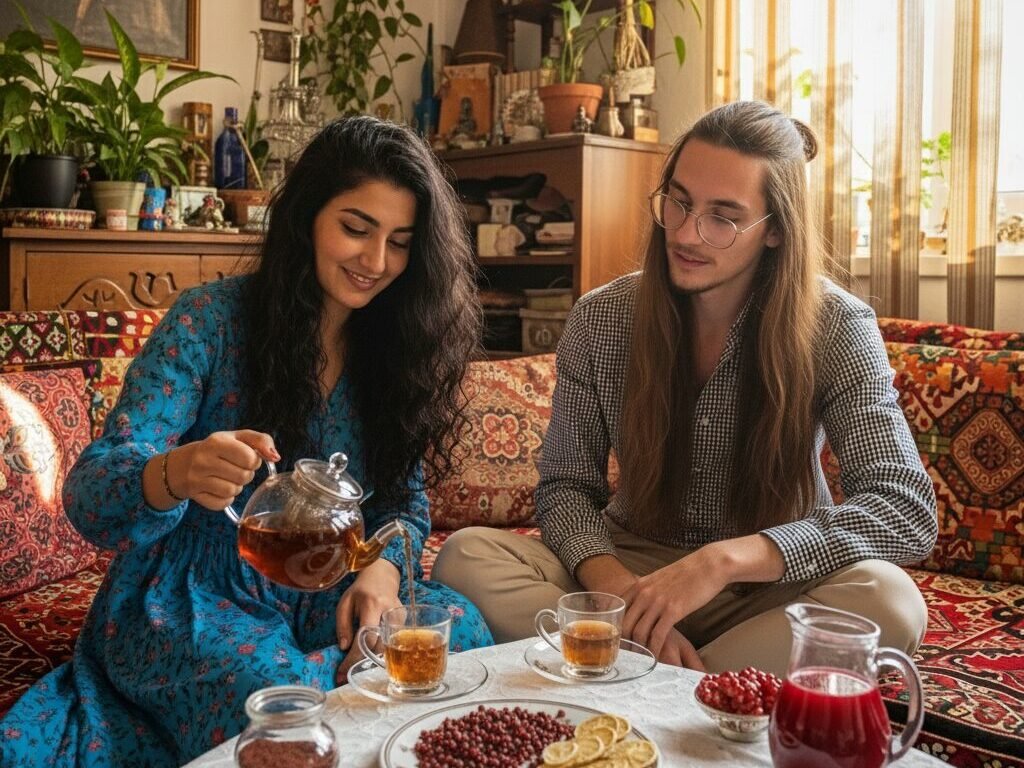
Step-by-Step Brewing Techniques
Brewing savory tea requires attention to detail and proper technique. The right methods will unlock the full flavor potential of your unique savory blends.
- Select fresh, filtered water for your tea base. Good water makes good tea and brings out the best in savory elements.
- Preheat your teapot or cup with hot water before adding tea. This simple step keeps your brew at the right temperature throughout steeping.
- Measure tea precisely using 1-2 teaspoons per cup for loose leaf varieties.
- Heat water to the correct temperature based on tea type. White and green teas need 170-185°F / 76-85°C while black teas require 210°F / 99°C for optimal extraction.
- Add savory ingredients like black pepper, ginger, or fennel at the right stage. Some flavors release better during steeping while others work best added after brewing.
- Steep for the recommended time to avoid bitterness. Most savory blends need 3-5 minutes, though this varies with ingredients like sage or rosemary.
- Strain completely to remove all tea leaves and solid ingredients. Clear broth showcases the complex flavors best.
- Serve in appropriate vessels that complement your tea’s character. Wide cups release aromas from herbaceous blends featuring lavender or mentha.
- Pair with complementary finger foods that enhance rather than overwhelm. Light crackers work well with delicate blends while heartier options match robust teas.
- Document your experiments with notes on temperature, timing, and flavor results. This record helps perfect your personal savory tea creations over time.
Temperature and serving suggestions play crucial roles in bringing out the best qualities in your savory tea blends.
Temperature and Serving Suggestions
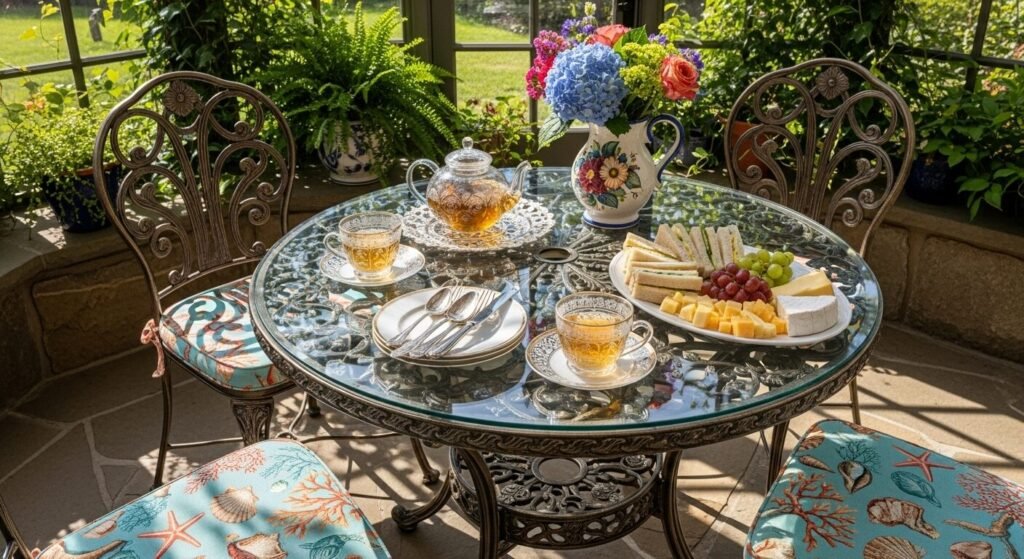
Perfect tea serving starts with the right temperature. Your savory tea experience depends greatly on how you heat and present your brew.
Water Temperature Guidelines
Delicate Teas (170-185°F / 77-85°C)
- White and green savory teas require cooler water to prevent bitterness and preserve their delicate flavors
- Allow boiling water to cool for 2-3 minutes before pouring over white tea and herb combinations for optimal flavor balance
- Test different temperatures within this range to find your perfect flavor balance for each delicate savory tea type
Robust Teas (210°F / 99°C)
- Black tea varieties like Darjeeling or Assam need hotter water to fully extract their robust flavors when paired with pomegranate or tamarind
- Black teas with bold additives like sumac benefit from the higher temperature for complete flavor development
Water Quality & Preparation
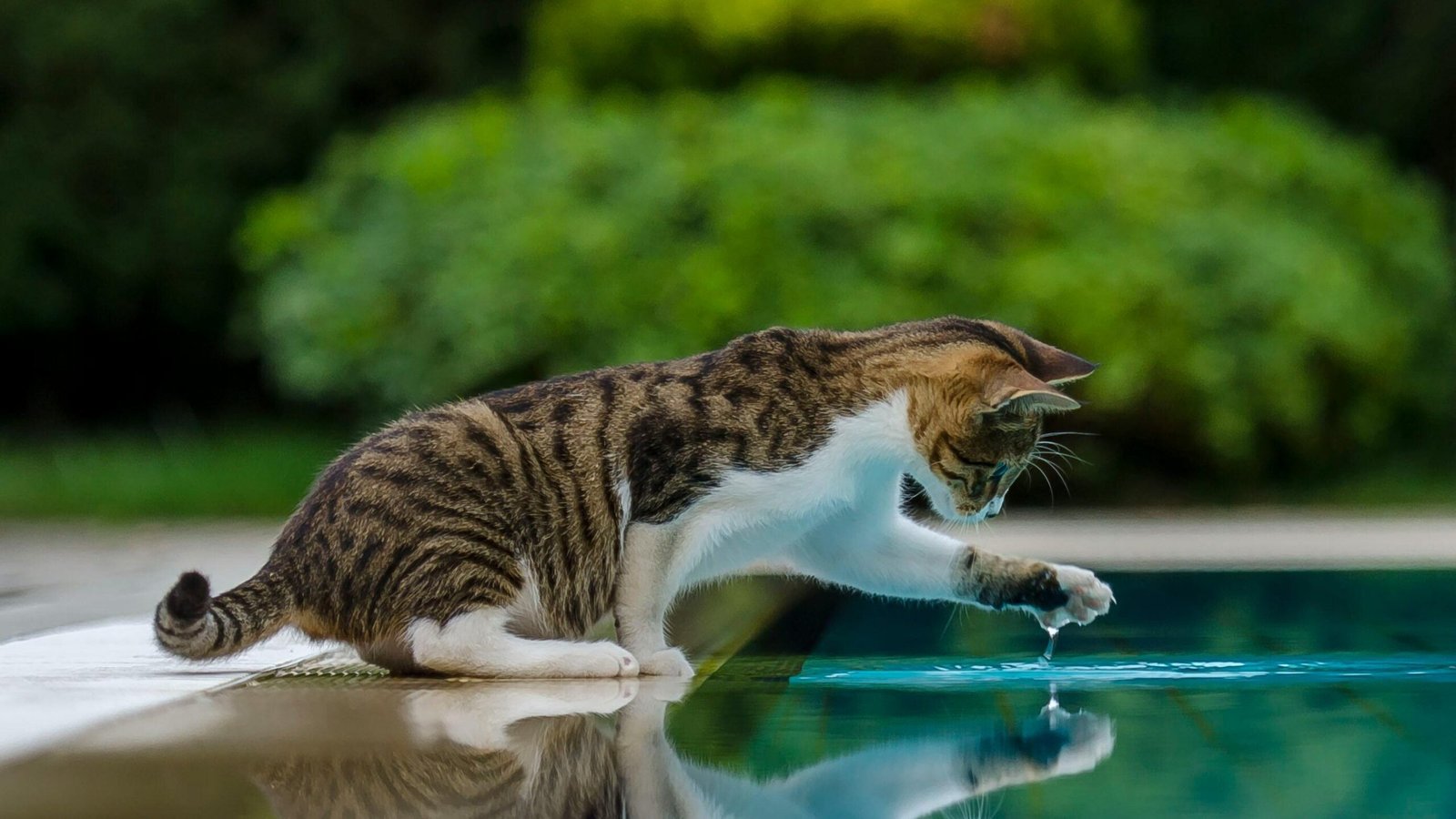
- Filtered water makes a significant difference in taste clarity, especially when adding subtle savory elements like basil or fennel spice
- Warm your teapot or cup before adding tea to maintain the proper brewing temperature throughout steeping
- Use unbleached loose-leaf tea filters for convenient brewing and easy cleanup with complex savory blends
Serving Suggestions
- Serve savory green teas like lime-infused Sencha in clear glass cups to showcase their vibrant colors
- Black teas with bold additives pair well in ceramic mugs that retain heat longer
- Chill certain savory teas like cranberry rooibos slightly for a refreshing summer drink option

Conclusion: Embracing Tea’s Versatile Savory Potential
Savory tea opens a whole new world of taste beyond sweet options. You can mix tart fruits like cranberry with earthy rooibos or blend smoky lapsang souchong with tangy sumac for amazing results.
These bold pairings work because they balance the natural flavors in tea with contrasting tastes. Try making your own blends at home with fresh ingredients and proper brewing times for each tea type.
The joy of savory tea lies in this freedom to create and discover flavors that match your personal taste while honoring tea’s rich traditions across cultures.
FAQs
1. What do you mean by “savory tea”?
In the context of this guide, “savory tea” isn’t a pre-made soup-like broth. It refers to the practice of enhancing traditional teas (like green, black, and herbal) by pairing them with tart, spicy, or umami ingredients. For example, adding a splash of lime to Sencha green tea or a pinch of sumac to Lapsang Souchong.
2. I’m new to this. What is a good savory pairing to try first?
A great and accessible starting point is the Lime and Sencha pairing mentioned in the article. The bright, tart citrus is a familiar flavor that beautifully complements the grassy notes of the green tea. Another easy and delicious option is adding a small amount of pomegranate juice to a robust black tea like Darjeeling or Ceylon.
3. Can I make these savory tea combinations iced?
Absolutely! Many of these pairings are fantastic when served cold. The Tamarind and Assam fusion or the Cranberry and Rooibos blend, for instance, make for incredibly refreshing iced teas. We recommend brewing the tea a little stronger than usual before chilling it and pouring it over ice.
4. Where can I find ingredients like sumac, za’atar, or black lime?
You can often find these spices in the international aisle of larger, well-stocked supermarkets. They are also readily available at specialty spice shops, Middle Eastern grocery stores, and online retailers. They are wonderful ingredients to have in your pantry for both tea experiments and general cooking.
5. Why is water temperature so important for these pairings?
The tea leaf is the foundation of your drink. Using the correct water temperature extracts the best flavor from the tea without creating bitterness, which would clash with your savory additions. As the article notes, delicate green and white teas need cooler water (170-185°F / 76-85°C) to protect their subtle notes, while robust black teas require hotter water (near boiling) to fully develop their deep flavors.
References
- https://jungachai.com/blogs/pairings/tea-pairing-101-match-the-right-tea-with-every-meal
- https://nature-design.co.uk/blogs/news/the-art-of-tea-pairing-enhancing-flavors-and-culinary-experiences
- https://adoretea.com/products/japanese-lime?srsltid=AfmBOoqI4gbCEB0cdNAt90iqpo-sU_wzsX0GsSmOI92xcOPyv8yhrd0w
- https://www.one-dragon-restaurant.com/tea-cocktails-and-mocktails-fun-tea-infusions-with-fruits-and-spices/
- https://blog.fusionteas.com/assam-black-tea-from-india-bold-malty-and-robust/
- https://artfultea.com/blogs/tea-wisdom/what-is-keemun-black-tea?srsltid=AfmBOopkPwrHrqhnMtFh8nx5t8iL1yq4FmUf9qCy-7XbeBdZqlBBC3Ru
- https://apothicateas.com/tea-compendium/
- https://tiestatea.com/products/fireberry?srsltid=AfmBOorud4KdU2zzQBbcCCpAOPnzVtdNEeu6efaQIqRmdyEiWKCTaBSR
- https://surekhaskitchenkindles.wordpress.com/2019/11/16/chamomile-zaatar-wild-thyme-herbal-tea%F0%9F%8C%BF-%E2%98%95%EF%B8%8F%F0%9F%8C%BF%E2%98%95%EF%B8%8F/
- https://www.savoryblendsteaco.com/
- https://teajtea.com/blogs/palates-and-pairings/tagged/best-tea-for-tea-party?srsltid=AfmBOoqmes8DXutZBy7xi3T4iXwJ89YKZNMiXe9fvSRk4lqh-z-sgzWP
- https://wilmax.com/blogs/article/tea-traditions-exploring-global-tea-cultures-and-pairings?srsltid=AfmBOooDQQQj2-8n90gekeiLym1MbcpYEsRHgBeVmRlHkS3ONU3dgfYb
- https://www.decorchiq.com/blogs/news/exploring-the-world-through-tea-regional-teas-and-traditions?srsltid=AfmBOoq1sC1v8tBrZWx30ff83ePtIsFuIkPqHrGPnZhD_4dRp2YzSuJI
- https://inpursuitoftea.com/pages/how-to-make-tea
- https://emilylaurae.com/how-to-make-homemade-tea-blends/ (2023-10-11)
- https://simplejoyfulfood.com/make-savory-cup-tea-using-dry-herbs/

